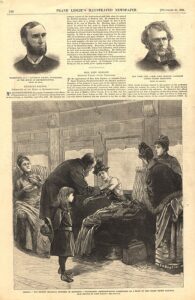
In 1883, the Ontario Medical College for Women opens. Three years later, the University of Toronto allows women to enroll.
People riot in Montreal after compulsory smallpox vaccines go into effect in the 1870s. In 1885, smallpox epidemics strike Montreal and Ottawa.
By 1890, surgery was a safe, successful and sanitary medical treatment.
Photo Credit: A doctor leans over and pricks the arm of a seated woman in a train car. Several other people either stand or sit and watch. 1885. Public domain.
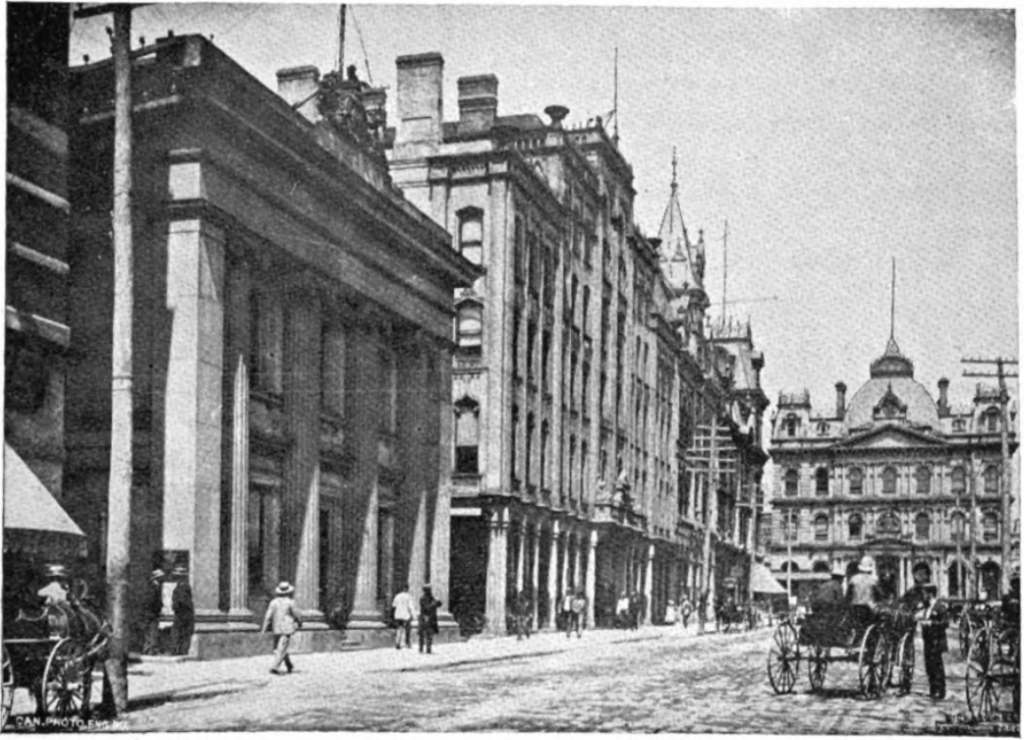
Between 1840 and 1900, the standard of living increased. The dollar purchased 25 percent more. As industrial output increased, prices fell.
Rent in the cities was high, and jobs usually were unskilled and routine. Factory work was brutal. So much so, that plants had their own prisons to lock up apprentices who breeched discipline.
In the 1880s, labor laws went into effect, although they were impossible to enforce. Boys under the age of 12 and girls younger than 14 were prohibited from working in Ontario and Quebec. In Nova Scotia, boys were required to be 10 before seeking work and 12 before working a 60-hour work week.
As the 19th century progressed, more people moved from the country to the city. Annually, freeze ups still caused winter layoffs, and an influx of workers reduced wages.
Photo Credit: Toronto Street before 1891. Public domain.
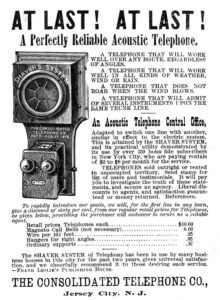
In the 1870s, homes were built with running water connected to sewer service. A decade later, they were built with telephones and electricity.
Ottawa’s first telephone book, published in 1882, contained 200 listings.
By 1890, large cities were a maze of overhead telephone, telegraph and electric wires.
Photo Credit: Advertisement for an acoustic telephone system by the Consolidated Telephone Co., Jersey City, NJ, 1886. Public domain.
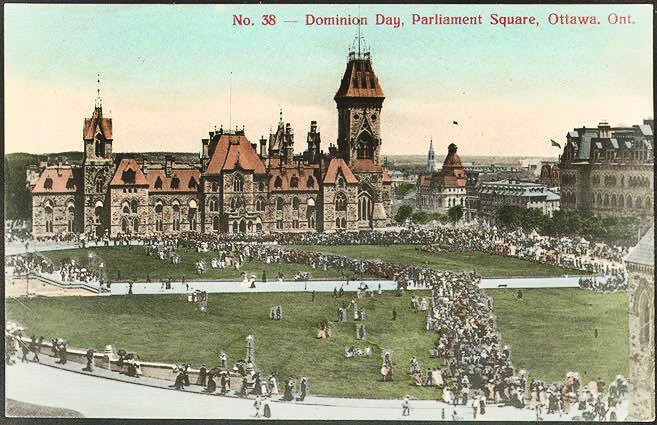
To be Canadian in the 19th century was to create Canada. The question was how. Independence from the British empire was easier said than done. Canada still need the UK to protect it from the American threat of annexation.
A small group of Liberals wanted to be annexed to the United States, and half a million Québécois moved to New England. In 1871, however, the Treaty of Washington settled many of the issues the United States and Canada had with one another.
Photo Credit: Dominion Day on Parliament Hill, early 1900s. Creative Commons Attribution-Share Alike 2.0 Generic.
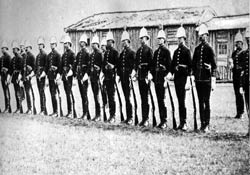
Buffalo herds began disappearing by the end of the 1870s. In the span of five years, tens of millions were killed and their bones sold as fertilizer.
Ranching became a viable profession when refrigerated ships allowed for the export of meat in 1880. In 1884, 54,000 head of live cattle were exported to the UK, a figure that doubled by the end of the century.
The Canadian government purchased land from the First Nation’s people for the construction of a transcontinental railroad. During the winter of 1883-84, one in 10 natives died on the plains.
Photo Credit: North-West Mounted Police post, 1875, Calgary. Public domain.
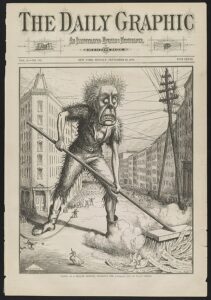
Some factories closed while others lowered wages. In other cases, adults were laid off and children took their place.
Thousands starved during the winter, and there were riots in Ottawa, Montreal and Kingston.
Montreal had the highest child mortality rate in North America with one in four babies dying before their first birthdays.
The cost of coal and wood skyrocketed.
Taverns located near factories offered cheap rum and whiskey, and alcohol consumption increased. This leads to the formation of the Woman’s Christian Temperance Union.
Photo Credit: Panic, as a health officer, sweeping the garbage out of Wall Street. Public domain.
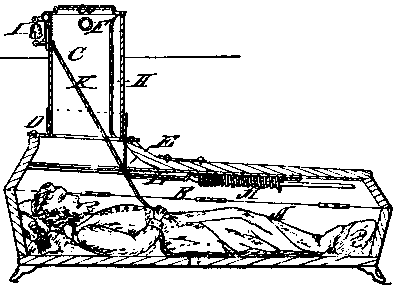
The fear of being buried alive led to the development of the safety coffin. This took many forms:
- Coffins with a glass lid. If the person was still alive, their breath would fog the glass.
- A rope was attached to the deceased’s wrist that rang a bell on the surface.
- Feeding tubes to ensure someone buried alive did not starve before rescue.
- Viewing tubes that allowed people on the surface to monitor the deceased to be sure he really was dead.
- Air tubes to prevent the buried person from suffocating.
- Escape hatches and ladders to the surface.
Despite all these innovations, there are no known cases of a safety coffin saving someone. There are, however, stories of people who awoke from a coma or other illnesses in their coffins before burial.
Photo Credit: “Improved Burial-Case”, US Patent No. 81,437 Issued: Aug. 25, 1868 Inventor: Franz Vester, Newark NJ. Public domain.
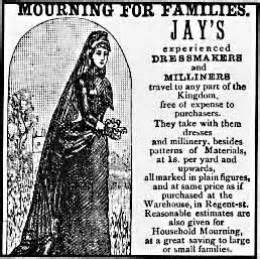
Victorians had a specific dress code for mourning. The rules dictated not only wardrobe, but what hats, gloves and jewelry could be worn.
The amount of time a person spent in mourning was determined by her relationship to the departed. Wives, for example, were expected to wear mourning dress for two years, but a husband only needed to mourn for a year.
Mourning dress was black, and people gradually returned color back into their wardrobes.
Why black? It was symbolic of sorrow and told the world the wearer was sorrowful without saying a word. Also, brightness was seen as disrespectful to the dead.
Part of the economy centered on mourning with businesses specializing in clothing and black crepe. Articles in fashion magazines instructed women on how they could dress stylishly and still abide by the rules.
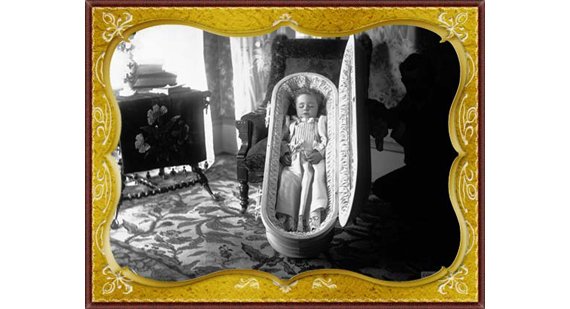
Post-mortem photographs (also known as death photos, mourning portraits or memorial portraits) were, as the name implies, taken of a deceased person. They were popular almost from the invention of photography until around 1900 when it became possible for ordinary people to own a camera.
In some families, the death photo was the only photograph a family would have of their loved one. It was meant to be used as a fond reminder of a loved one, not to provoke sadness.
Bodies were arranged as if they were alive, often posed with living family members. Other photos featured bodies in bed surrounded by flowers or even in their coffins; these often were of infants or children.
To mimic life, the deceased was posed using props that kept the body upright. Eyelids were either propped open or the eyes were painted on.
Photographers developed tricks to assist them in their work. They experimented with lighting and photo retouching.
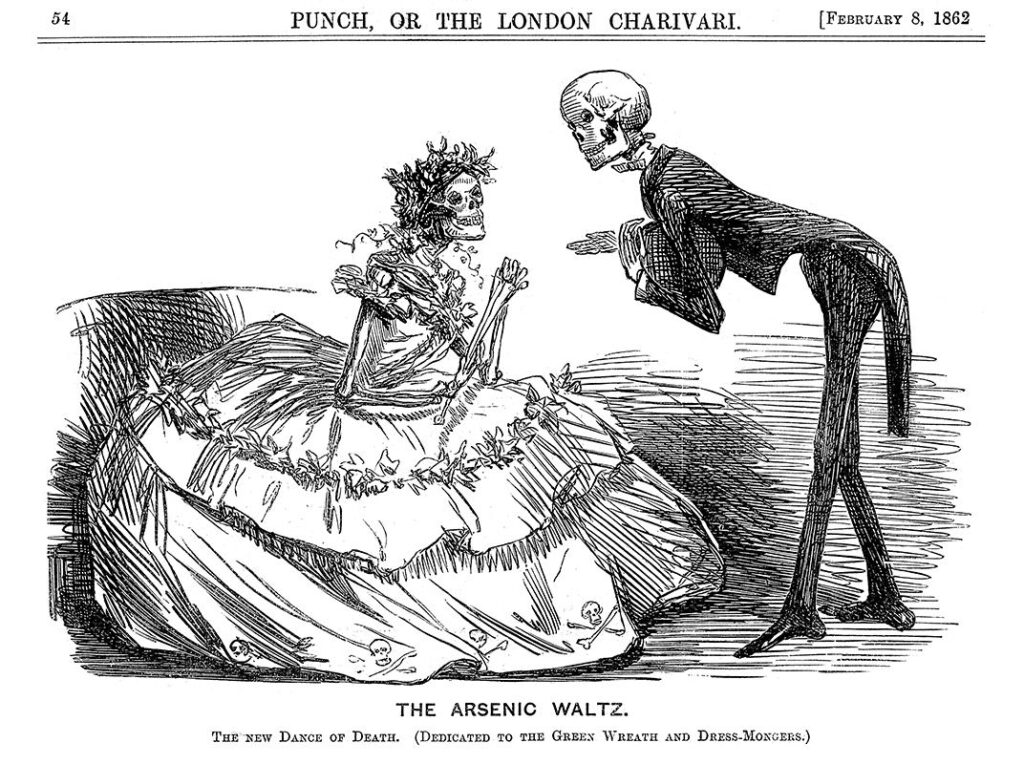
From the mid-19th century until the late 1920s, arsenic was found in a variety of products. People knew it was poisonous, but believed it had to be ingested to be harmful. Little did they realize products containing arsenic still could release the poison into the air.
Arsenic was used mostly in color pigments and was found in fabrics, household products, toys, baby carriages and numerous other items. The poison also was used in medical and beauty products such as eczema pills, sex enhancers, acne medications, shampoos and asthma cures. Finally, arsenic was found in rat poison, making it the most common way in the Victorian era to poison not just rats but your enemies.
Arsenic made it possible for manufacturers to produce vibrant colors. Green was especially in demand.
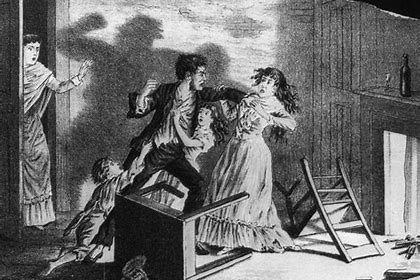
For most of history, domestic violence and spousal rape were part of everyday life. Why was this violence accepted? Because it was the natural order of things. A man was supposed to display his authority over his family. Therefore, it was legal for a husband to force himself on his wife and to beat her and their children. Things, however, slowly began to change during the mid-Victorian era.
In England and the United States, domestic violence was tolerated by law so long as the victim’s wounds could not be seen in public. Women could leave an abusive partner, but abuse was not legal grounds for divorce.
In 1882, Maryland became the first state to pass laws criminalizing domestic abuse. An offender could be sentenced to time in prison or to be whipped with 40 lashes. Reforms in Britain began around the same time and included, among other things, the right to divorce after a life-threatening beating.
It wasn’t until the 1970s that men faced harsher penalties for abuse, women could divorce because of abuse, and abuse could be considered in custody battles. It wasn’t until 1993 that United Nations declared spousal rape a violation of human rights.
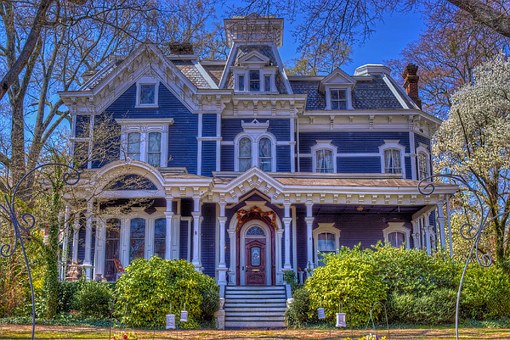
Gothic Revival gets its name from Gothic architecture popular during the Middle Ages. The revival started as early as the 18th century, but is associated with the late 19th and early 20th centuries.
Architectural characteristics:
- Arches, gables and towers
- Pitched roofs
- Pointed windows
- Lacy trim
- Homes had porches and two floors
- Asymmetrical floorplans
- Decorative ornamentation
Famous Gothic Revival buildings include Canada’s Parliament Hill, United Kingdom’s Houses of Parliament, New York City’s St. Patrick’s Cathedral, and the buildings of Boston College.
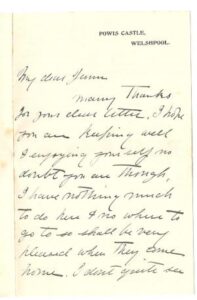
During the Victorian era, letter writing became commonplace: more people could read, mail delivery had become more reliable, and it connected loved ones who were too far away to visit.
Written communication came with its own set of long, complicated rules. The Victorians, however, were people known for their long, complicated rules, so this shouldn’t be surprising.
Victorians were dictated by the rules of society as to what they could and could not say. The letter was an extension of polite society; therefore, if one wanted to express certain feelings, such as love, symbolism and figures of speech were used. Sometimes the opposite of what was meant was said, yet at the same time, people were encouraged to be truthful in feeling. In informal letters, people were told to write in the same manner they spoke.
Books were written on the art of letter writing. Two popular ones were The Lover’s Casket and The Lovers Letter Writer.

Dec. 31, 1879, is the day Thomas Edison first demonstrated his incandescent lightbulb in Menlo Park, NJ.
The lightbulb was nothing new in 1879. It had been around longer than the 32-year-old Edison. Older model lightbulbs were expensive and didn’t burn for long. Edison and his research team merely perfected the lightbulb, making modern electrification of cities possible.
On that fateful winter night, Edison’s workshop and the street were illuminated. Scores of people showed up to watch between 50 and 60 lights, the Camden, NJ, Courier-Post reported.
Edison “should keep increasing this number daily, as rapidly as was practical, and in five weeks he hoped that he would have 800 lights burning,” the paper said Jan. 1, 1880. “He should increase the number of the lights as fast as he could increase his facilities for generating the electricity.”
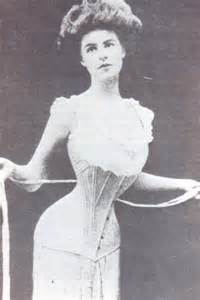
Corsets have been part of a woman’s wardrobe since antiquity. Over the centuries, they evolved and changed.
The constricting garment that 21st century minds often think of is the underwear of the upper classes, so constricting it needed a second person to pull it tight. Women in the middle and lower classes also wore corsets, but because these women didn’t have a personal servant, they had to dress themselves. Their corsets opened and closed in the front and were not as binding.
The history of the corset is tied to the history of fashion and what is or is not considered beautiful. When being thin was in fashion, so were corsets.
By the mid-Victorian period, corsets were lined with whalebone to allow women to fit into dresses that had increasingly tighter bodices and smaller waists. During this timeframe, corsets gave women an hourglass shape.
That changed during the Edwardian period. The Gibson Girl of the 1890s popularized the S-curve. This shape emphasized a woman’s bust and butt, pushing both outward, while slimming the waistline. Also during this time, corsets began being seen as lingerie and were decorated.
This photo above was doctored in the Victorian era to make her waist looks smaller.
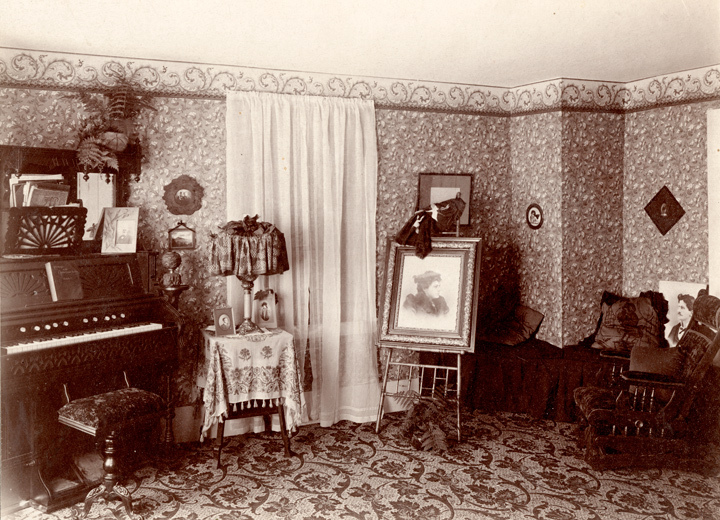
More than a century ago, music education was considered important, and every family that could afford a piano owned one. Some homes even had dedicated music rooms.
Before the advent of radio and television, playing music and singing was one way families could entertain themselves. Retailers sold inexpensive sheet music that allowed all but the poorest families to build a music library.
So what did a turn-of-the-20th-century music room look like? Placement of the piano was the most important aspect of the room. Pianos were placed in a way that would produce the best sound while also hiding the instrument’s inner components. Great care was taken to protect the piano’s finish.
Like most Victorian and Edwardian rooms, music rooms were decorated in rich colors and contained numerous knickknacks.
Music rooms were used whenever there was a party. Guests with musical talent would be persuaded to perform.
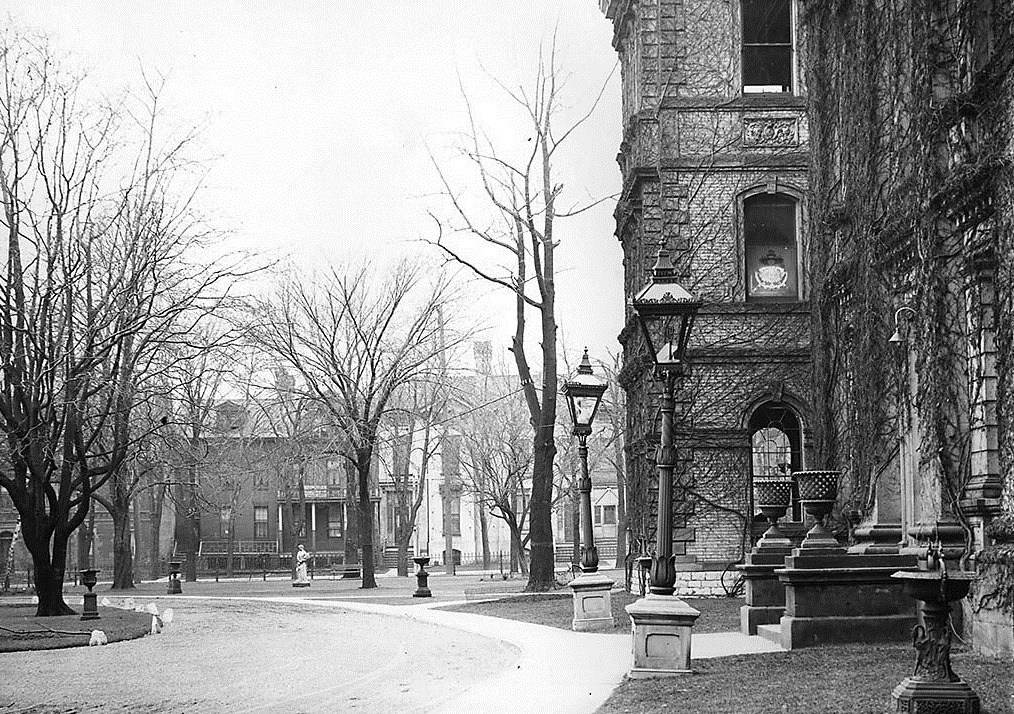
Lucretia became a professional teacher after attending the Toronto Normal School in the 1880s.
What was a “normal school”? It is what today we call a teaching college. The purpose of these schools was to teach norms, standardized teaching practices.
Several normal schools were established in Canada and the United States in the 19th century and continued to operate until the mid-20th century. In Canada, teaching colleges were absorbed into universities while in the United States they became independent universities. Many state universities have their roots as normal schools.
The school went through several name changes, before becoming the Toronto Normal School in 1875. It was the oldest school in the province of Ontario. By the 1880s, the campus had others purposes as well. The property also held a natural history and art museum, a botanical garden, the headquarters for the Ontario Department of Education and an art school.
To be accepted into the school, students needed one year of teaching experience, a session at a model school and an academic second-class certificate.
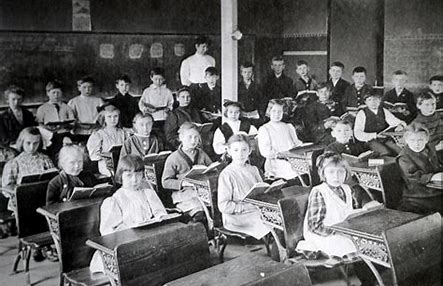
If you were a student in the late 19th and early 20th centuries, you would have been given a classical education. This was especially true for boys. Girls were taught more feminine subjects such as music, needlework and home management, but increasingly they, too, were becoming educated.
Students of a classic education studied numerous subjects. Today, some of these subjects seem odd to teach children. The subjects were:
- Reading
- Writing
- Classic literature
- Latin
- Greek
- Logic, examining and analyzing ideas
- Rhetoric, debating ideas
- Arithmetic
- Music
- Astronomy
- Architecture
- History
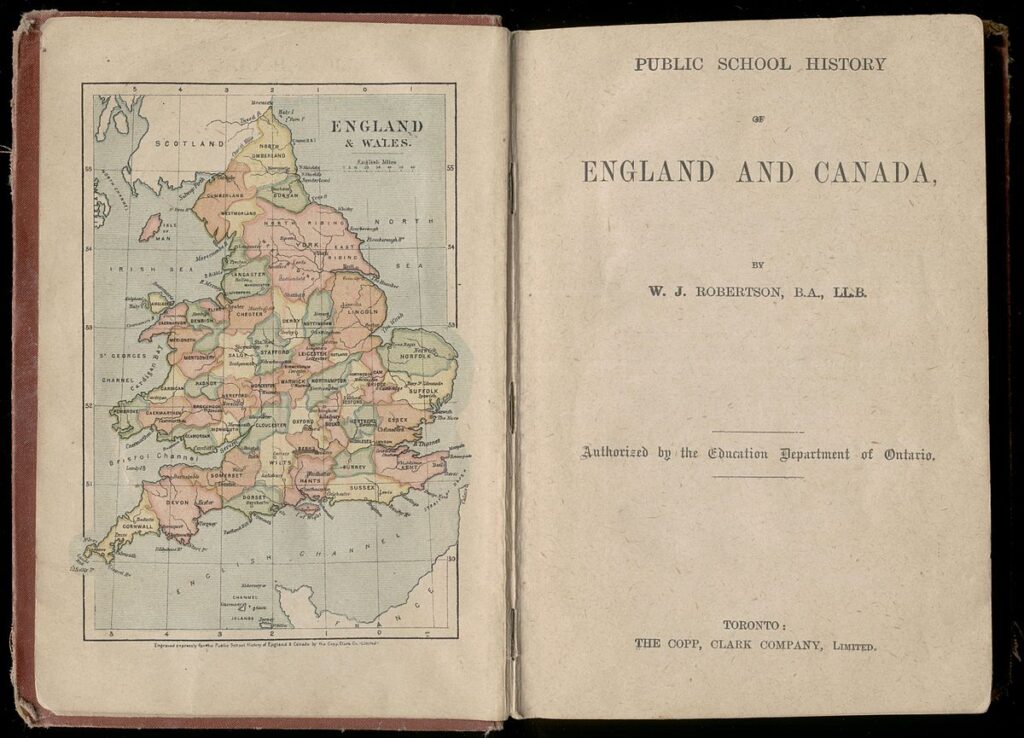
The Public School History of England and Canada, published in 1892, by William John Robertson and the Education Department of Ontario.
